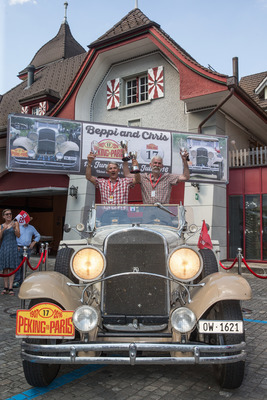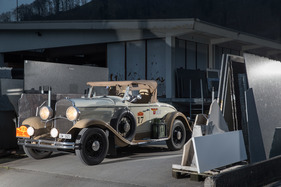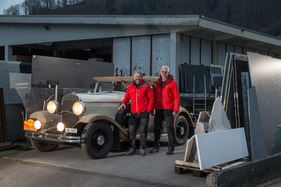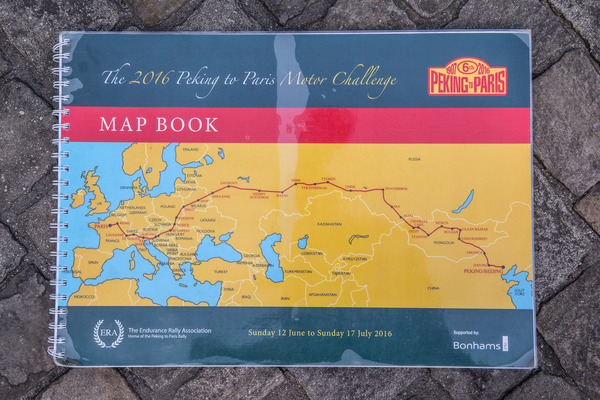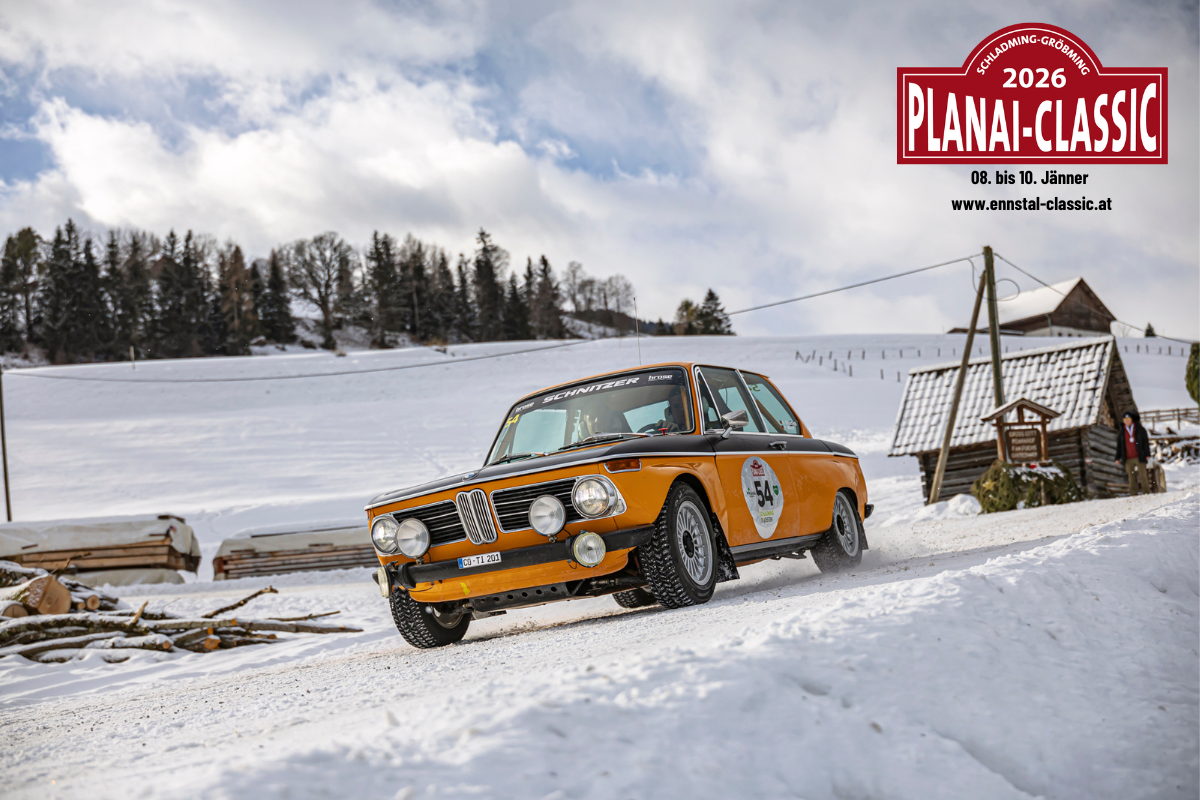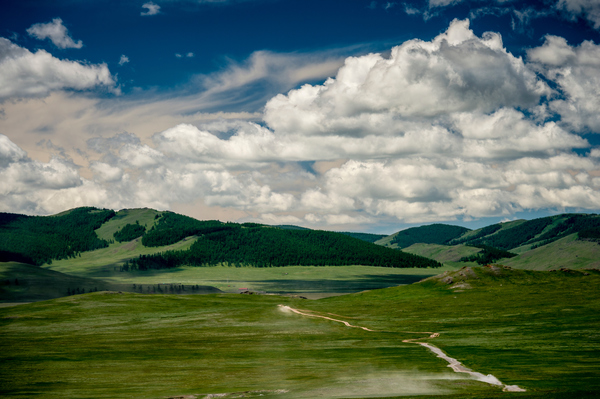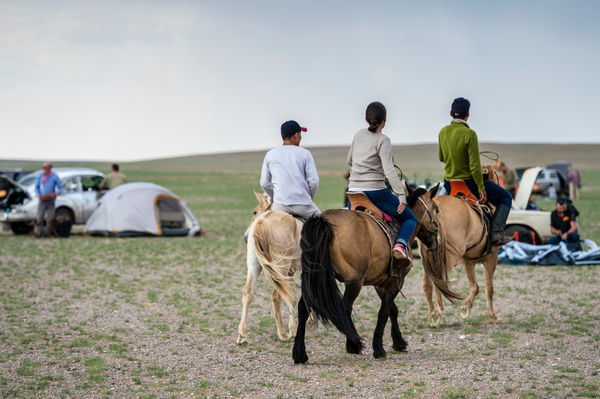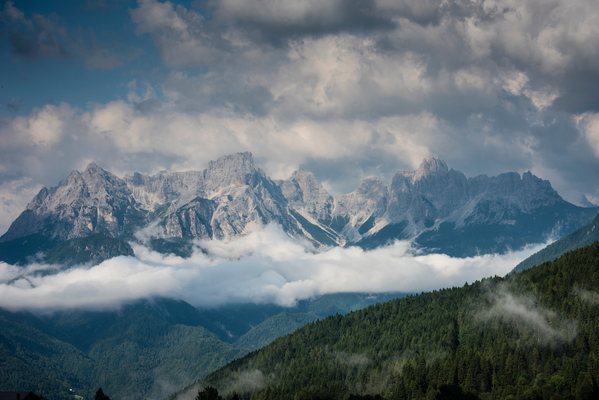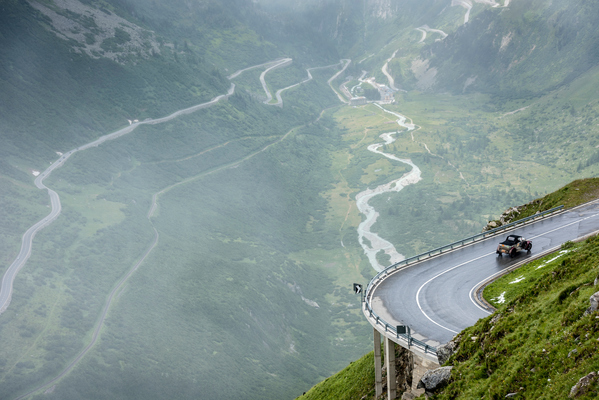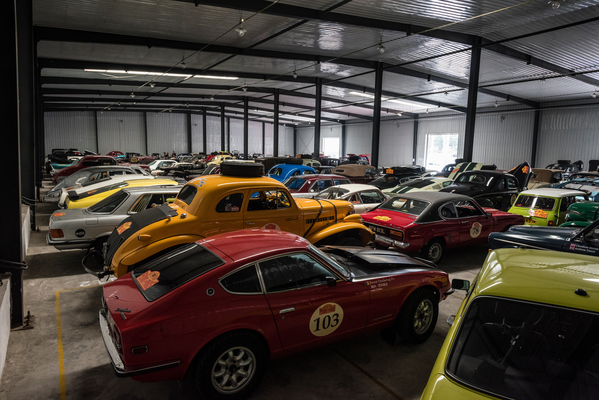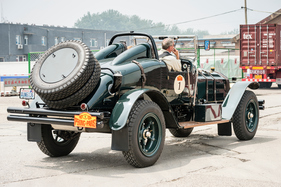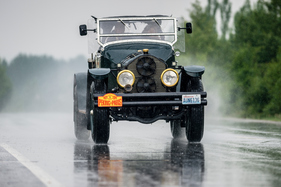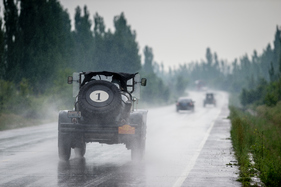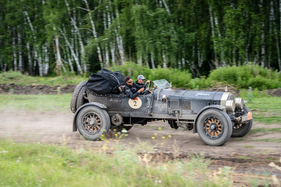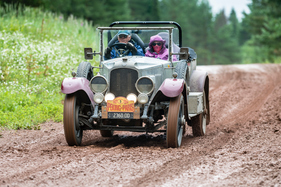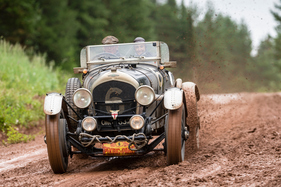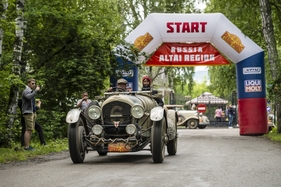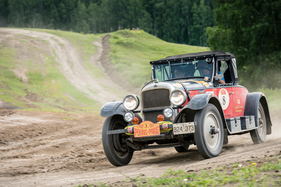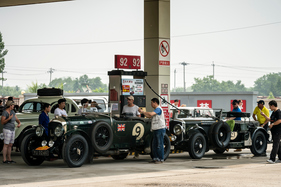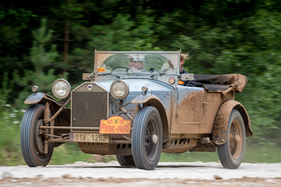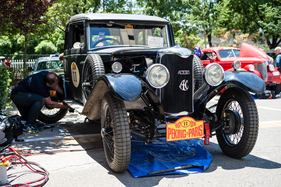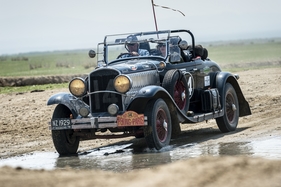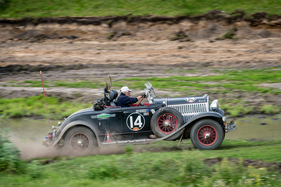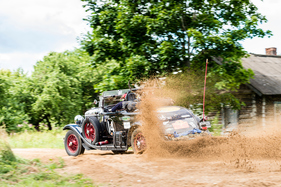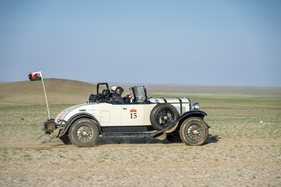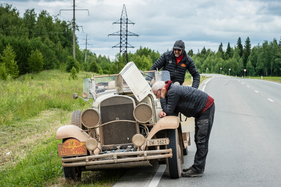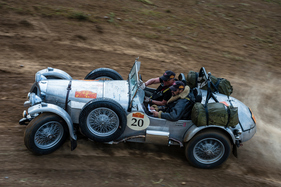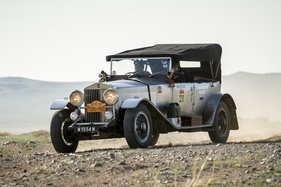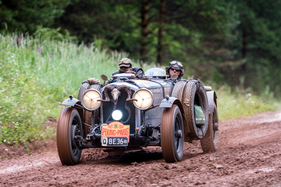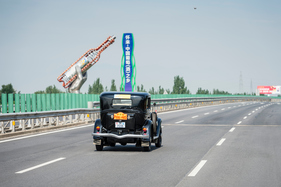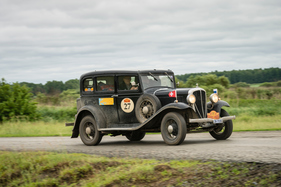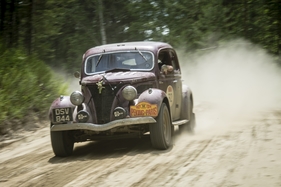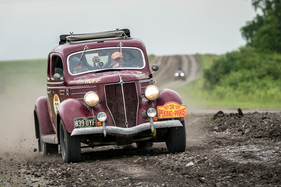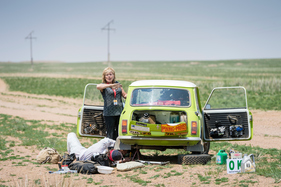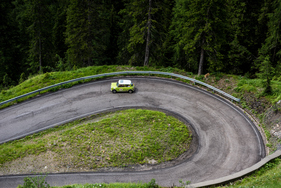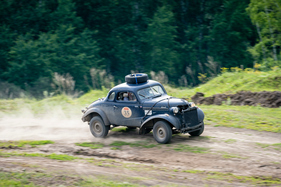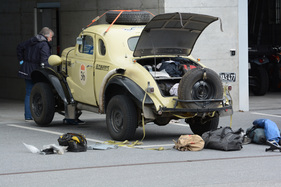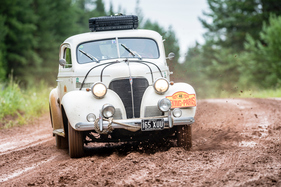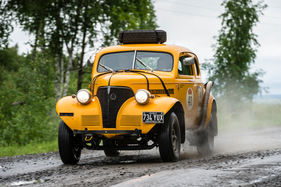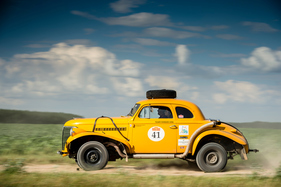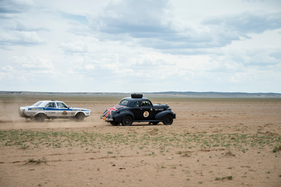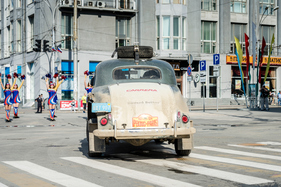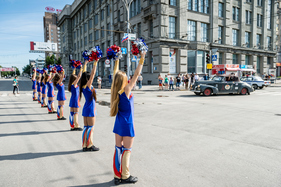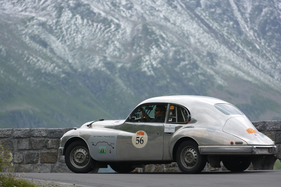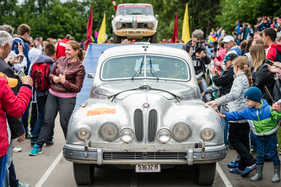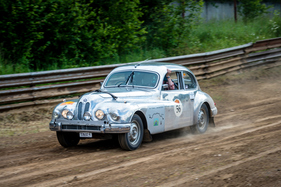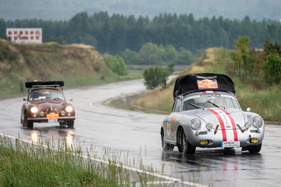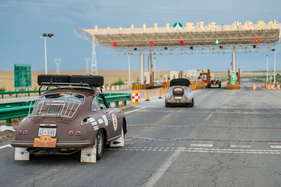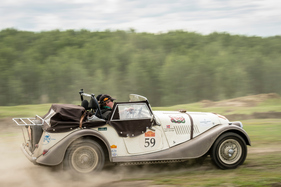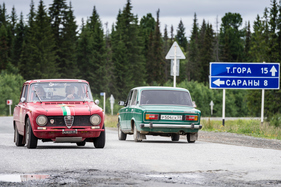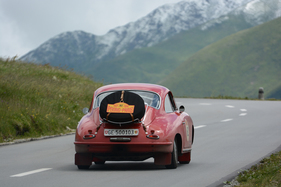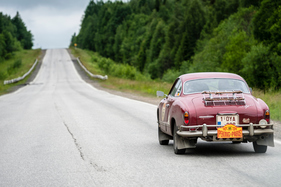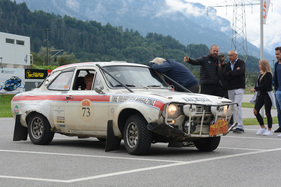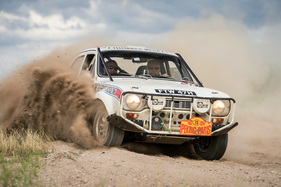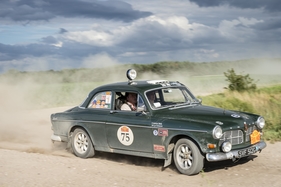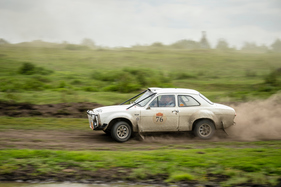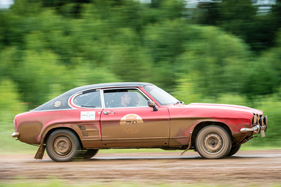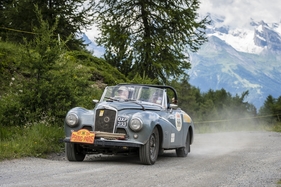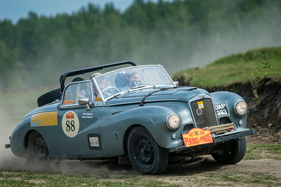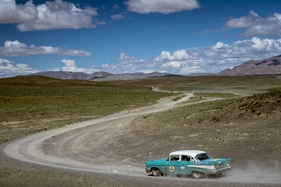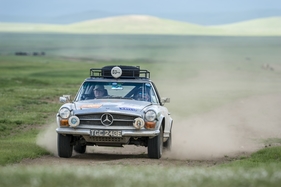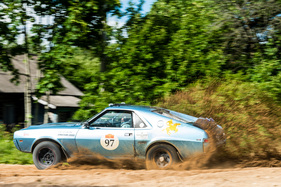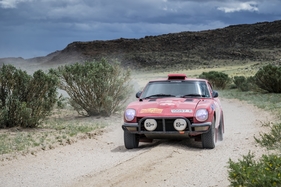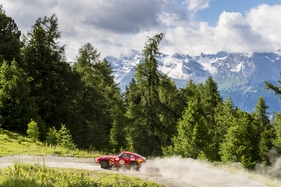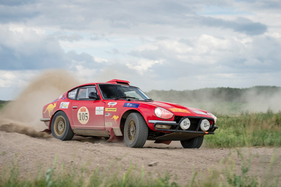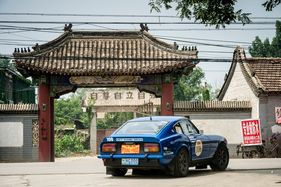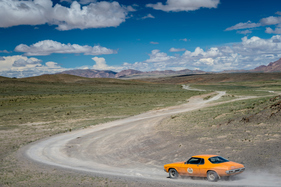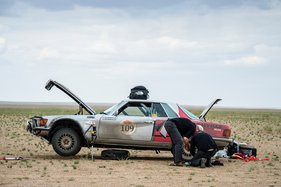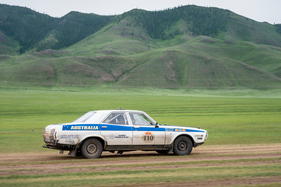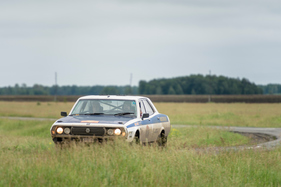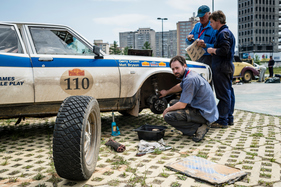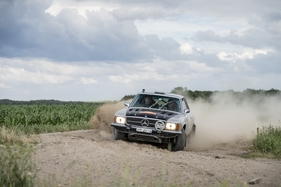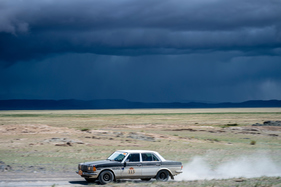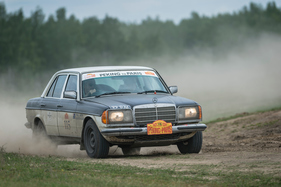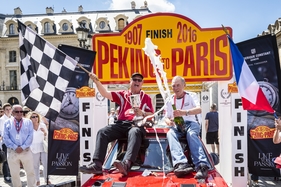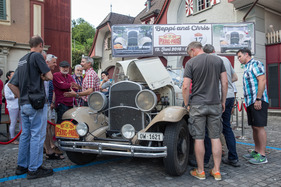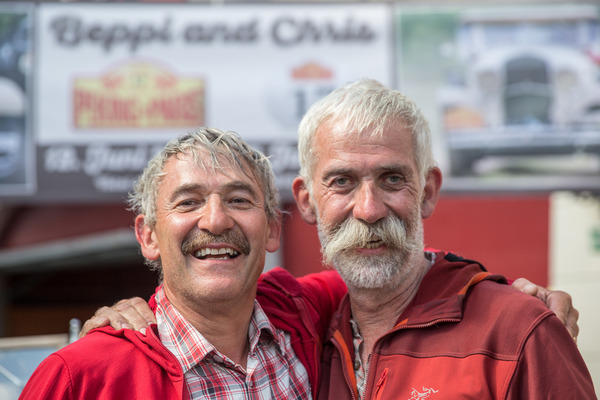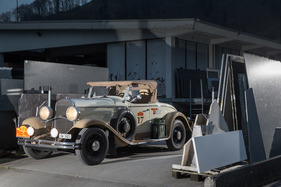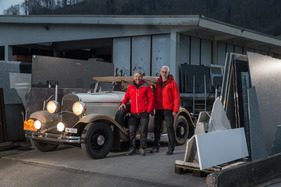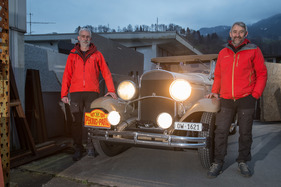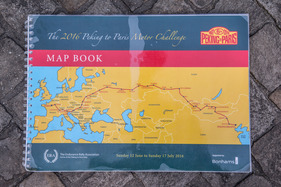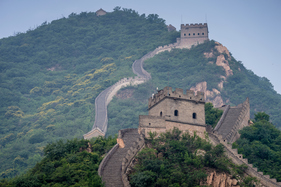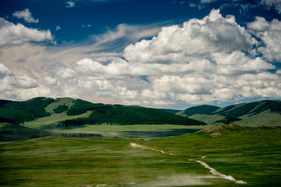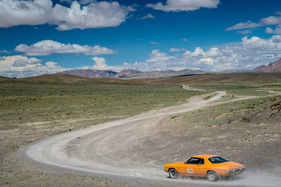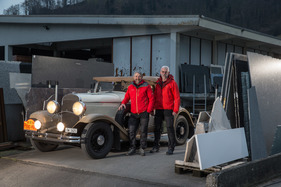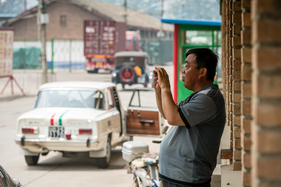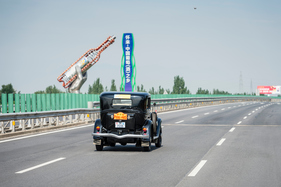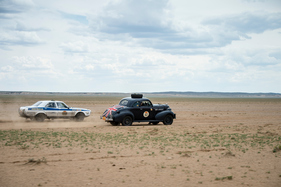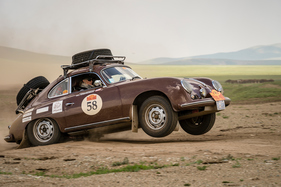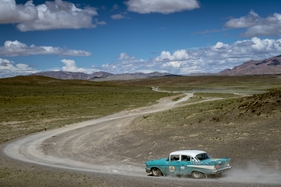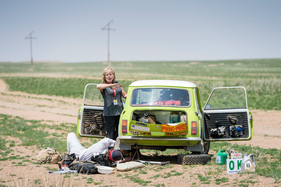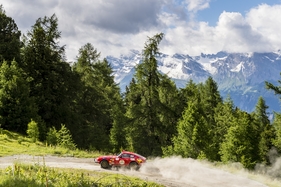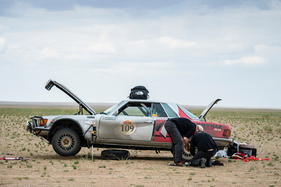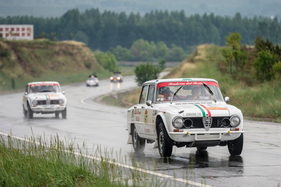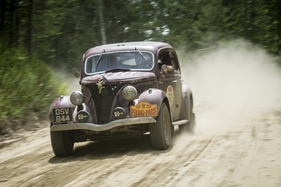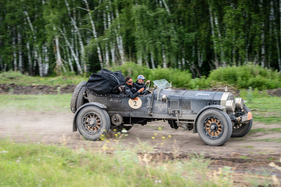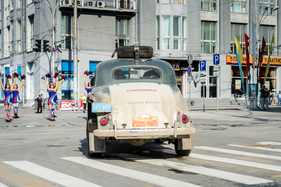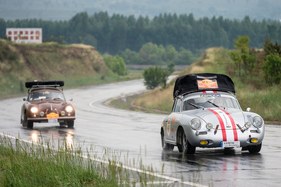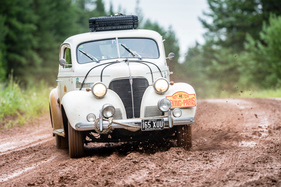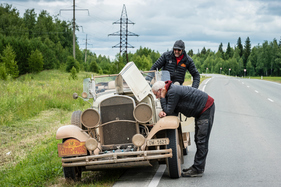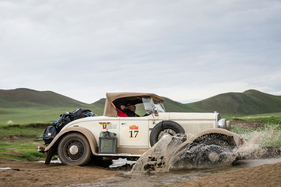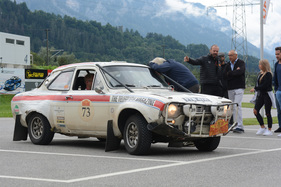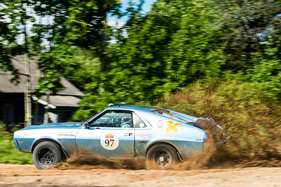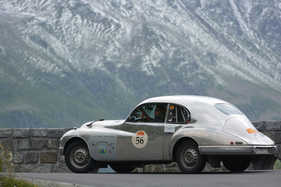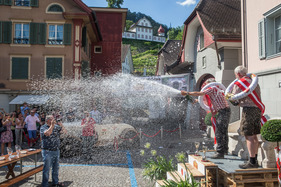What would her reaction be to the following suggestion from a friend: "Why don't we visit our colleagues in Beijing? I'll drive my Chrysler 70 (built in 1930)." It's not 500 km like a quick trip to South Tyrol, no, it would be around 13,000 km and you would have to plan around 36 days of driving time. Most people would probably think that the colleague is now completely off the rails. Only a few would and could imagine such a journey in an old car. But it is actually feasible. Not overnight, though, because such an undertaking requires a lot of preparation.
Almost fully booked two years in advance
The rally from Beijing to Paris, organized by the "ERA" (The Endurance Rally Association), takes place every three years. Anyone who thinks you can just sign up and take part is very much mistaken. Starting places are limited and coveted despite the very high entry fees. The rally for 2016 was practically fully booked by the end of 2014. The Swiss brother team Dillier was almost laughed at when they tried to register with a Jaguar Mark II they had bought at auction on the internet.
With lots of chocolate in their luggage, they were given the opportunity to take part with a pre-war car at a personal audition in England. As a result, they found a Packard 8 cylinder with a displacement of three liters on the Internet, bought it and registered it on February 10, 2015, without ever having seen the car. However, the deal with the Packard did not work out, but shortly afterwards the brothers found a Chrysler 70 in Michigan. The car was bought and transported to Switzerland, where it was first registered for road traffic and then photographed for registration. Afterwards, it was calmly dismantled down to the last screw and rebuilt and reinforced.
Despite the two brothers Christian and Beppi Dillier's extensive knowledge of vehicles - after all, they run a transport company with a sizeable fleet - they also had to call in professional outside help to prepare the car as planned. Among other things, new bearings and brake drums were cast. The entire electrical system was rewired, a dual-circuit brake system was installed, mud flaps were fitted and the windshield was converted to laminated glass. The chassis was reinforced and a metal plate was fitted to protect the oil pan.
The following criteria are required by the "ERA" for participating vehicles: originality and all associated identification papers, functioning lights, mud flaps and laminated glass. The following must be carried: Medical kit, satellite phone, tow rope, navigation system with tracker so that tracking is possible.
The car was completed on February 16, 2016 and now had to be put through its paces before being loaded onto the ship to China on March 21.
Test run
As the brothers didn't have the slightest rally experience, they quickly added the "Costa Brava Rally" with the Jaguar MKll in July. The Dilliers quickly realized that rally navigation is not without its challenges and got a little cold feet, as it was certainly much easier to get lost in Mongolia than on the well-signposted Costa Brava.
But Beppi and Christian Dillier were not to be deterred, after all they had acquired a taste for it a year earlier in Ticino when they had watched a film about what was probably their last great adventure (Beijing-Paris). And for Beppi's 60th birthday, they wanted to experience exactly the same adventure. The little bit of navigation was certainly not going to ruin everything.
While "Heiri", the name of the Chrysler, made up of the two first names of their wives "Hei" for Heidi and "Ri" for Rita, traveled across the water to Beijing, Christian began to keep a rally diary, which he used until the end to record his impressions and the events of the rally. With excerpts from this diary, we are now traveling virtually with the rally team:
June 10
Today is the day on which the question of whether and in what condition our Heiri has arrived in Beijing is resolved. We could hardly wait for the time and boarded the 10 a.m. bus instead of the noon bus (so that not everyone stormed the camp house at once, the organization tried to divide us into groups..... and some participants were quite surprised that the 10 a.m. bus was completely overcrowded).
When we arrived at the camp house, we found Heiri in great shape. Barely two or three revolutions and the engine was humming. Off to the next gas station. The Chinese were overwhelmed by the rush and apparently so was a German crew filling their 450 SL petrol engine with diesel. In the evening, all the Swiss teams met up for dinner.
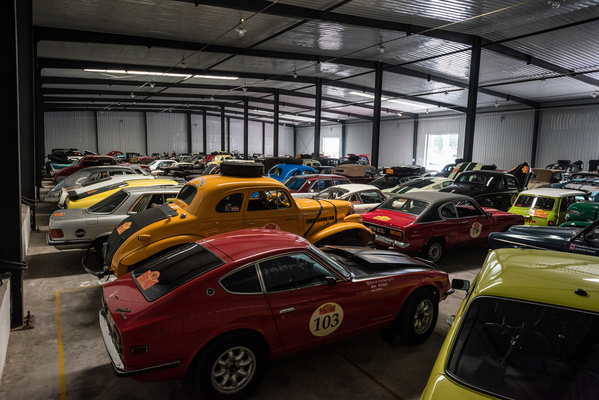
Editor's addition: For the first time, there was also to be a team classification. This novelty was only announced shortly before the start. Teams of three had to form in order to take part in the classification. Why not a Chrysler team, the brothers thought, and approached the two other Chrysler drivers. These experienced rally participants were initially critical. As the Dilliers had no rally experience apart from the Costa Brava, the Paris-Peking-tested other Chrysler drivers were not very keen on having rookies in the team. But they found each other and this bold decision proved to be very successful right up to the end.
June 11
Today was the big day of "scrutineering", i.e. the technical acceptance and inspection of the accessories that comply with the regulations, such as tow rope, SOS kit, satellite phone, etc. We also had a number of talks and discussions. We also had a number of conversations and discussions with other rally participants, including about the correct setting and operation of the Garmin GPS. We both still have great respect for navigation....
To reassure us, however, we were given a good hour of official information about navigation, including the road book and GPS, as well as instructions for tomorrow's start.
Beppi and I did some final fitness work, combined with a sauna infusion, followed by a quick dinner and then an early night's sleep.
June 12
04:15 Wake-up call and shower. Then to the car with the luggage and try to untie all the heavy bags. Questions like: Are you going on vacation for a few months after the rally? What bodies are you still dragging with you? Or, have you been chased out of the house by your wives with bag and baggage?
Another quick and nervous breakfast, then at six o'clock we set off in the direction of Great Walls. Once there, Chinese dragon dances were performed for us.
The official start of the rally is at 8 a.m. sharp and the journey from Beijing to Datong, a city with a population of 1.5 million, is rather provincial for China.
This first day was mainly used to get used to the surroundings, the car and the navigation. Outside of Beijing, the driving style of the locals was even more chaotic and we shared the roads with many exotic trucks that would be taken off the road immediately in Switzerland ...
The first stage of 400 km posed no problems for us and we had fun. However, the sumptuous dinner with chicken feet next to the Chinese black forest cake took some getting used to.
June 13
Today we had around 600 km to cover from Datong to Erenhot in Inner Mongolia in the People's Republic of China. The first big scare came on the second day: After refueling, we could no longer start Heiri and had to push him.
Back at the hotel, we made our first analyzes and thought that either the battery was discharged due to alternator damage or that the starter had given up the ghost. However, it turned out that it was just a problem with the battery.
June 14
Wake up at 5:00 am. The stage leads to Undershireet, around 400 km long, with a border crossing and on into the Gobi desert. Heiri had to be pushed again before the start. Then there was a huge procedure for leaving China. They couldn't find my entry stamp and I was already sitting in the office. I was already accused of entering the country illegally, but the boss finally found the ominous stamp and everything was fine again.
The first big adventure was the time race in the Gobi Desert. But oh shock, even before the first time trial, the fixation of the rear right shock absorber tore off. It was taped to the bodywork......and on we went through the desert at up to 80 km/h, all on sand and stone.... we got through.
June 15
After the first night in the tent, the journey continued to Ulan Baatar, the capital of Mongolia, which with 1.4 million inhabitants is home to almost half of Mongolia's total population.
In the timed race on difficult - unpredictable holes and ruts, sandy and partly stony ground - the lower rear fixation of both shock absorbers broke off. As it turned out later, it was a design fault. When the car hit a block, there were around seven millimeters missing from the rubber buffer. As the impact could not be cushioned, the mountings broke. Both shock absorbers were taped to the rear bumper until a Mongolian later welded the two brackets back onto the car from below and all the Mongols present jumped around on the car for the final inspection.
One of the bigger timed races was really tough and included a steep climb. Unfortunately, Heiri didn't make it, despite all the encouragement from the Mongolian shouts. Beppi had to turn around, drive down and look for a less steep road. We lost a lot of time.
Our friends Claus and Tjorven were very lucky when the track rod on their Bentley broke shortly after the timed race. They spent the night in the cab of a Russian truck, which took their damaged Bentley to a garage in Ulaan Baatar for four dollars per kilometer.
When we arrived at our destination, we immediately went to a garage and welded from 6 p.m. until midnight. Among other things, Heiri got a completely new adjustment of the rear upper shock absorber fixation. This was moved to the rear so that the more oblique angle gives the two shock absorbers a longer path to prevent them from hitting the end lock in the event of complete buckling.
June 16
The first rest day turned into a really hard day's work. We wanted to take advantage of the insider tip from Ruedi, a Swiss colleague, that the Mercedes workshop in Ulan Baatan was well equipped for repairs. But everyone else knew the insider tip too, so we weren't completely alone. A closer analysis showed that our gel battery was defective. I managed to persuade a German tourist who was there to drive me to the market in his Nissan to buy a new battery. The adventure in Chinese traffic took around two hours. But the new acid-based battery brought Heiri's starter motor back to life. Beppi and I also checked all the main components and carried out the necessary service work. Many of the bolts on the car had to be retightened due to the stresses and strains of the last few days.
June 17
From Ulaan Baatar, the journey continued to Bulgan, a 340 km stretch with completely different faces. The first half was on a relatively good asphalt road, but with tedious column driving out of the city. The second section, however, was a real challenge, with typical desert rally driving on stony, sandy and dangerous ruts.
Almost all the Swiss riders completed the day with flying colors and so we celebrated in the evening with wine and beer in the Swiss tent castle. Only two were missing. Manu and Röbi, who unfortunately suffered major damage to their Rockne Six. The left front wheel was torn off in one of the ruts. Mongolian truck drivers came to the rescue and welded the steering knuckle back together with the help of two truck batteries, which held for at least the next 50 km.
June 18
The 350 km from Bulgan to Murun was another ordeal for all vehicles. Very stony and hilly roads led us through the impressive Mongolian landscape.
June 19
For the 390 km from Murun to Uliastai, it was an advantage to have sufficient ground clearance. Once again, the good choice of our Chrysler Roadster was confirmed. We had the impression that we were able to experience everything the Gobi Desert has to offer. We crossed rivers, hilly areas, drove on deeply rutted terrain (ruts up to 40 cm deep) and on very stony roads that could easily have slashed the differential ...
And, as it should be, also time sections on soft, sandy and winding roads. Bravo to all those who managed this route in cars with low ground clearance, such as our friends Beat and Peter with their Mustang or other cars like the Mini or the Morgan.
In the evening, our help was needed for a team job on Renate and Andreas' Chevy Coupé. Both leaf springs were broken. By joining forces, we managed to get the vehicle roadworthy again. It was impressive how other Chevy teams were immediately prepared to hand over their spare springs.
June 20
As the printer went on strike, we had to make cell phone copies of the route changes early in the morning in the pouring rain. Today we went from Uliastai to Chjargas Lake, about 350 km. The Gobi Desert once again showed its contrasts. Start in cold and damp weather with horizontal rain at 1770 meters above sea level up to 2000 meters and then back down to 1000 meters to the camp with more pleasant temperatures but a lot of wind.
Beppi set very good times, but on the third time trial the navigator (Chris) failed and we had to turn around after a short climb and approach the finish from the opposite direction. But the important thing was that we were still on course for a gold medal.

When we arrived at the camp at Chjargas Lake, we had to wait almost three hours for the fuel truck, and we were the sixth car in the queue. The gasoline only flowed by centrifugal force (no pump) and the fuel hose was designed more for mopeds. This meant that refueling took the whole night and a time table had to be drawn up for the participants.
Our Chrysler was a bit battered again. The front right shock absorber was torn off. We had to create a new fix, which took around two hours. Five cars were unable to drive to the camp under their own power, and another dozen vehicles had moderate to severe problems.
I myself had to contend with problems of a different kind. With the arrival of a violent storm, setting up the tent became a challenge. The storm became so violent that the tents had to be taken down again. Unfortunately, a tent pole was broken during this procedure and the outer shell was slightly slashed.
June 21
The last day in Mongolia and the remaining 350 km towards the Russian border were very impressive. We steadily gained altitude and often drove on sandy tracks, comparable to a 6-lane highway. Simply "awesome" to drive and a unique experience. Our last camp in Olgiy was at an altitude of 2100 meters. At Heiri's camp, we only had to tighten the shock absorbers again with the screw that we had just managed to save from the time trial at lunchtime.
Half a dozen cars only made it to the day's destination on the back of one of these older Mongolian/Russian trucks. Half the night was spent welding and hammering. The night was cold and in the morning the outer tent was covered in frost.
June 22
At eight o'clock we set off in convoy at full speed towards the Russian border. Fortunately, the organizers had allowed plenty of time and set up the next camp in Altai just 120 km after the border.
We needed an enormous amount of patience to cross the border. First when leaving Mongolia and then for the Russian entry. How can you spend five hours extremely inefficiently....? Fortunately, we only had to drive a total of 180 km today.
We arrived at the camp earlier than usual and almost no paperwork was necessary. We were most pleased that Ruedi had joined us again with his Chevrolet, albeit only on four cylinders. The evening before, Claus in particular had tried everything to get Ruedi's Chevy going again: From the ignition distributor, ignition, cable replacement, plugs, to the fuel supply. Frustrating!
June 23
Today was a somewhat longer drive from Altai to Aya. Heiri's start was at exactly 7:24 am. The distance would have been no problem on asphalt, but almost half of it was on gravel roads. There was also a time trial with four sections where you had to arrive exactly on time. The average speed was set very high for these road conditions, as it was actually a pure forest road. There was also a steep section in the second section, which pushed Heiri to the limits of his strength. Overall, we were on time in three sections, only in the fourth we were given a time penalty of two minutes because of the steep section.
We really had to race, which kept Beppi's enthusiasm in check.
June 24
Well rested, we continued today on a 560 km stage from Aya to Novosibirsk, the third largest city in Russia. This included two time trials on sandy ground through the forest, which was very exhausting for our Chrysler. It was a very dusty but great fun affair. Too bad if you broke down; a few teams swallowed a lot of dust! The dirt was then really washed away at the hotel bar in the evening. Two timed races had to be canceled due to a heavy thunderstorm the day before.
P.S. For some inexplicable reason, Ruedi's Chevy ran like oil again and showed the necessary torque and sufficient power. Maybe a combination of better gas and less altitude.
June 25th
So-called rest day, but actually better service and repair day, wellness for Heiri. Breakfast at 7:00 a.m. with Quentin, the boss of the local CAT dealer. Straight to the CAT workshop at 8:00. A good half dozen mechanics, electricians and welders were waiting for us there, led by service director Simon. The main problem was to find a good solution for fixing the front shock absorbers. After several discussions and with the help of a precision mechanic's workshop, whose boss came to work especially for us, we found the right solution. Heiri got the full service he deserved: all the fluids and filters were changed, the grease gun was used extensively, the spare wheel bracket was hammered back into place with some effort, and the doors were straightened so that they could be closed normally again.
Conclusion: Heiri looked like new again. In the evening, a classical concert by the Novosibirsk Philharmonic Orchestra was on the program.
June 26
The official start was at 8:00 in front of the Marriott Hotel. For us this meant 8:35, as we had made up places. The better, the later the start. At this point we were in 12th place in the Vintageant Category and in 3rd place in our 1929/30 class.
It was a long and exhausting day, with our extra loops outside the program we covered over 700 km from Novosibirsk to Omsk.
We had really lost our way and found ourselves somewhere in the middle of nowhere on country lanes and farm tracks. We were actually looking for a special stage, but it literally fell through anyway due to poor and muddy conditions.
In the evening in Omsk, the first thing we had to do was to change the fixing of the front left shock absorber. Fortunately, the CAT dealer gave us two additional, complete sets of the new version.
June 27
Today Beppi drove the long and tiring route from Omsk to Tyumen, about 680 km and a lot of asphalt, with only one major, beautiful detour into the villages. In between, it had rained quite heavily and visibility was dangerously limited. As usual, we only stopped to refuel and for some snacks in the early afternoon.
In the evening, the differential oil was checked and we were happy that, contrary to our fears, there was no major loss. In Novosibirsk we had to top up with around 1.5 liters of oil, which was quite a lot for a total volume of 2.5 liters.
June 28
Changes to the road book again. The time trial was canceled due to heavy rain, but we were able to drive two individual events on an autocross track. That was great fun. Otherwise it was a relatively quiet and relaxed day for us with "only" 380 km. In contrast to the previous team of Jan and René, who wanted to drive a whole day and the whole night before from Novosibirsk to Ekaterinburg in their Buick Cabriolet, but were stopped by bad luck again. A hole in the piston of the 7th cylinder prevented the Buick from moving forward.
June 29
All in all, the 480 km drive from Ekaterinburg to Perm was fairly comfortable and not too strenuous. Only the weather was very unfriendly today, but we knew how to dress appropriately.
Another discussion about our faulty tracker, which hadn't let us track our journey for about 10 days, finally bore fruit and we got a new one.
June 30
A very exhausting day from Perm to Kazan with almost 700 km ...
For several hundred kilometers, the road was littered with potholes, where you thought from a distance that a hare was hiding, but then you had to avoid a hole in which even a donkey would have found a good place. By the way, we are talking about asphalt highways here.
Our routes often led through beautiful landscapes and small villages. However, tar was not yet known there. It felt as if we were driving through fields and meadows where some old Russian bulldozer had ploughed a lane so that we had to wind our way through sand and clay soil with lots of furrows and holes. Our Heiri gave himself and his crew a good shake.
There were also two special stages against the clock on sand and clay. The number was not without danger, as oncoming traffic, including some trucks, did not always want to get out of the way immediately. At speed, what we had feared for some time happened. A loud bang and the alternator gave up the ghost.
The battery is strong enough for the power consumption, but the water pump has to be driven. Beppi had the brilliant idea and tied three cable ties together to act as a V-belt between the crankshaft and the water pump pulley. This enabled us to cover the 80 km to the Kazan race track without any problems and we still managed to set good lap times.
July 1
It's amazing how on this service day (and again not a rest day) most of the teams arrived for breakfast before six o'clock. Bruce, the Kiwi man, didn't hesitate for a second and handed us his spare alternator. Mike also contacted the service guys for advice on the loose spokes. Graeme, the local CAT dealer, picked us up and we followed him to Mantrac's workshop.
Four or five people were already waiting for us there and immediately set to work constructing a new bracket for the alternator. As on the last rest day, Heiri was put through his paces. At around 4 p.m., we brought Heiri back to the hotel parking lot, resplendent in its former glory, where a huge crowd of people marveled at our cars.
July 2
For once, the 420 km from Kazan to Nizhny Novgorod were entirely on asphalt. The originally planned route would have led over sand, gravel and dirt roads, but had to be changed at short notice due to heavy rain, as did the special stages.
July 3
Today was 480 km from Nizhny Novgorod to Zavidovo with several special stages in super nice and warm weather. We were able to start the day with the time trial on the official circuit of Nizhny Novogorod, about 30 km outside the city.
There were also special stages on a sand track with inclines and lots of snaking bends. Finally, there was also one on asphalt. As it turned out late in the evening, we were able to defend our 11th place well. We found ourselves in a sandwich of three Bentleys, two in front and one behind us. However, all three have at least twice the horsepower. During the vehicle check, a leaking brake cylinder was discovered on the front right.
July 4
We covered most of the route from Zavidovo to Smolensk on good asphalt roads. Unfortunately, it started to rain again and for the last 200 of the 540 km it poured like buckets. We could hardly see anything. We drove further special stages on two race tracks. In the evening, a cab helped us to find the hotel, which could only be due to the poor directions. The cab was immediately confiscated and with sign language and an address he was supposed to lead us to a garage that must know something about spoked wheels. In the end, however, it was nothing but expenses, as the people only touched the spokes in amazement and discussed amongst themselves....
Back in the hotel parking lot, we reinstalled the thermostat and carried out the usual checks. Unfortunately, we found another loose spoke on the front right wheel, which we had trouble tightening. The spokes are the biggest worry at the moment.
July 5
Today was another real marathon. Over 700 kilometers under a wide variety of weather and road conditions meant that we didn't reach the finish line in Minsk until after 20:00. But the special stages on sand were great fun. With the 60 horses we achieved very acceptable times, which helped us to distance Willy (one place behind us) with his Bentley Derby to 8 minutes. In Polatsk, the geographical center of Europe, we had an hour's lunch break.
July 6
The temperatures were still chilly and the sun didn't want to make an appearance. We decided to start with the roof closed. As it turned out later, this was a good idea. The journey from Minsk to Brest was around 450 km. Just 60 km after the start was the first special stage on sand. Beppi drove a very good time and in the second run we improved by 8 seconds. Again there was an obligatory lunch break.
This was followed by a good 150 kilometers of highway, half of which was on dead straight roads, which helped with navigation, as it was raining extremely heavily in places, which caused aquaplaning and miserable visibility. Shortly before Brest, another special stage took place in very poor conditions on a stretch with huge potholes. Heiri had to suffer. What made matters worse was that we had to drive the same route twice. The conditions were not ideal, as slower and faster cars were sent out onto the track with short gaps between them. Overtaking was extremely difficult, which led to scenes of stinky fingers and "car pushing".
It really is worth checking your car at the end of each day. Today we found an unnatural amount of play in the steering. The steering rod on the left-hand side had come loose and the thread was badly strained by the knocks. Fortunately, we were able to screw in two extra turns on the left side and loosen it on the right side accordingly to maintain the track. We hoped that this trick would be a permanent solution, at least until Paris.
July 7
Today the whole convoy moved from Belarus to Poland, including a drive of about 320 km to Rezeszow. The border crossing took "only" just under two hours. First of all, the exit formalities, although this procedure always surprised me, especially when you are leaving the country. We had to show our passports at least four times..... Getting a job...
There were mainly two types of uniforms, those with a stiff hat and those with a perret. We couldn't quite work out the exact difference, but stiff hat certainly meant "sharp dog"! Speaking of dogs, a couple of dachshunds were also there to sniff for drugs, but our dirty laundry put them off.
July 8
From a specially built launch pad, we were sent off on our onward journey from the town market square in Rezescow to much applause. The best thing about the day was that we were allowed to drive to Kosice in sunshine and without rain. It was a real treat to drive through the beautiful countryside in an open Chrysler. The four special stages of the day again demanded full concentration. Heiri was really challenged again with the climbs and descents. A few horsepower and stronger brakes would have helped today. Fortunately, we still had the handbrake.....
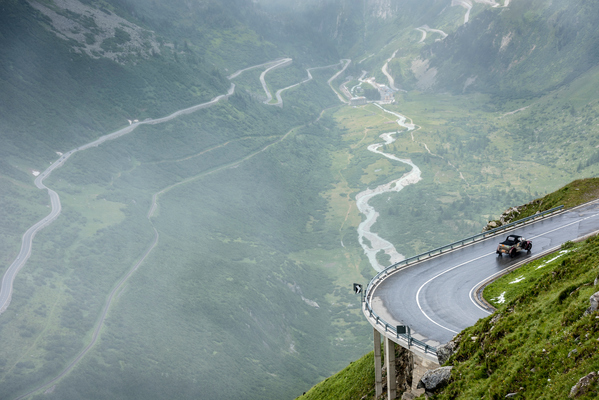
All these races are not without danger, as we saw today. A Ford Escort overturned, fortunately without personal injury. The local helpers tried to get the dog bone back into its old shape with hammers and crowbars.
A Mustang, which was in second place in the Classic classification, went off the track, overturned, hit trees and slid 30 m down the slope, luckily coming to a halt just short of the lake. The co-driver escaped with a shock, but the driver had to be hospitalized with minor back and shoulder problems. The Mustang was probably a total loss.
In the evening in Kosice, we discovered at least five loose spokes on the right front wheel and decided to replace it with the last remaining spare wheel.
July 9
And on we went in good weather to Hungary, precisely to its capital Budapest. Small mountain passes gave us a foretaste of the Alps to come. The special stages again took place on very bad roads, which again caused our Heiri a lot of pain. But our biggest problem remained the spokes.
We were still able to maintain our 11th place. We had gained an extra two minutes towards the back of the field and there wasn't much more we could do towards the front, unless someone else dropped out. And we still had to get through.
July 10
To minimize the risk of a retirement, we brought Heiri, the Chevy with starting number 40 and the Mustang number 68 to the HUNTRACO CAT workshop. Andreas has to replace the drive shaft bearing on his Chevy. On the subject of material procurement: Andreas' son Simon and his wife Yvonne arrived in Budapest a day early with a bus full of spare parts. Among other things, they brought Emmanuel's new front axle, four new shock absorbers for us, an alternator plus small parts and a new chain and much more for Ingo's La France.
The highlight for Beppi and me was of course the arrival of spoke doctor Moser, who checked all six wheels and had to replace five of the six spokes.
We also took the opportunity to slim down: we removed the front armor steel protection and the two canisters on the sides. A lot of material and clothing was removed. Every kilogram counts, as the Heiri with its 60 hp had enough to do on its own through the Alpine passes.
July 11
Under a steel-blue sky, the rally continued to Maribor, 440 km away. Once again, we had exciting timed races on gravel and dirt and also across forests. One of the cars went off the track again. This time it was a 1938 Ford Coupé, and we waited for over an hour in the 36 degree heat until the track was cleared. Heiri was causing us more and more headaches. Several spokes on the front right had come loose again and the wheel was making a lot of noise. Other noises that we hadn't noticed yet came from the chassis or the suspension. But perhaps we were already hearing noises where there were none.
July 12
Today was the day of the special stages. A distance of 300 km on many small roads with constant ups and downs, on small passes resulted in a total driving time of 8.5 hours. By way of comparison, the direct ride from Maribor to Ljubljana of around 180 km took around 2.5 hours. It was such a criss-cross route that I thought I would pass one or two villages and farms two or three times.
But the special stages on closed gravel roads were great fun again. Our big concern was still the spokes, the inner row was also starting to come loose. During the lunch break at over 30 degrees I tried to tighten them as best I could. On one of the race courses, we had to complete a timed skills course with a slalom through extremely offset pillons. A lot more pylons were shot down than passed through.
Unfortunately, there was a serious accident during the sixth time trial. Our German friends Helmut and co-driver Michael rolled over in their open Bentley. Both were allegedly thrown out of the car, but Helmut ended up under the car. The exercise was stopped immediately. But to the delight of all participants, Helmut was transferred to Frankfurt just three days later and was in a stable condition. Conclusion: chest crushed, various rib fractures and other minor fractures, but all major organs intact. At least.
July 13
We were the first team to get Heiri out of the underground parking garage today. But oh shock, within the first twenty meters we discovered that the spokes of the new front wheel were also loose. After a fast breakfast, we set off in search of a garage with a lifting platform or jack so that we could swap the wheels on the right-hand side of the car. Then a quick refuel, enter the roadbook changes and off to the start.
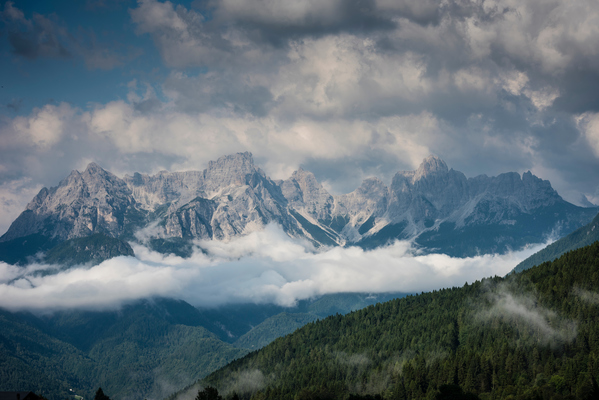
The upcoming day trip was 500 km long and led from Ljubljana to San Martina di Castrozza. As soon as we crossed the Italian border, it began to rain, sometimes so heavily that visibility shrank to less than five meters. There was also fog. As a result of these lousy conditions, two special stages over the passes were canceled, but the ride still followed the specified route. We drove by the book, other teams cut corners and chose the direct route. They were severely punished for this, as "passage controls" were held in the mountains instead of time trials.
July 14
Journey home. The weather forecast promised snow and it had actually snowed, but the evening before. At the official start at 7:30 it was still quite cloudy. Contrary to expectations, the sun shone more and more through the clouds and after the two special stages we were able to open the roof. There was a short lunch break at Lago di Molvena. The last two special stages were canceled. We approached the Swiss border over more passes.
After a short stop and a hug from the Swiss teams present, we continued over the Bernina Pass to St. Moritz, where we were greeted by many Obwalden friends with flags and fanfares.
July 15
For the last time, a big stage with several passes from St. Moritz to Lausanne and a distance of 450 km was on the agenda. Even before the start, there was a great deal of nervousness. A handwritten note announced that the Albula Pass had to be closed due to snowfall, so we were diverted via the Julier, Oberalp and Furka. Today was absolute weather chaos. Light rain at the start, snow on the passes and the closer we got to Lausanne, the warmer and sunnier the day became.
The very last special stage of the rally from Beijing to Paris took place on the Croix de Coeur from Tzoumaz to Verbier on gravel. My personal goal was to move up from eighth to seventh place. So we had to be a good two minutes faster than father and son Matt and John Pecham in their Chevy Coupe.
The motto was full throttle and Heiri gave it his all. I can already tell you that we drove one of the best times ever, but in the end we were a "shitty" seven seconds off. We lost them in a hairpin where a steep road led away at 90 degrees, which we mistakenly shot up and then had to roll back onto the actual route.
July 16
The second-last stage took us 520 km to Reims in the Champagne region. The day was cool but sunny. Nevertheless, we left Switzerland with the roof down and continued through France. As there were no more special stages, we only had to pass the "passage controls" on time.
July 17
There were only 200 km to go to Paris, but the journey was still an ordeal, at least for me as navigator, but also for Heiri. We passed through hundreds of small villages on this last stage, all on minor roads and I had the feeling that we were passing thousands of traffic lights and traffic circles.
When we arrived in Paris, we had to join a queue and were released in groups of ten. It was a great, but also relieving feeling to arrive safely and in good shape on our own four wheels after almost 14,000 km and to drive through the finish gate. Our Chrysler friends had already reserved a place for Heiri and so he stood between the first and second-placed drivers.
The gala dinner dragged on with all the prize-giving. Despite our tiredness, Beppi and I were overjoyed as we were asked to come up to the stage several times: A gold medal for meeting and fulfilling strict daily targets. Only 30 out of 102 were able to fulfill these strict conditions. Winner of the Chrysler team classification, third in our class (but were able to take first prize as the first two in our class, Bruce and Mike were already the first two in the Vintageant category). Overall, we came 8th with 284 hours 53 minutes and 39 seconds. We were just those cursed seven seconds short of seventh place overall. For the 32 real rally days (without the 4 rest days) we had spent nine hours a day driving in the car.
July 18
As if that wasn't enough, the three of us (with Heiri) drove back from Paris to our home in Sarnen at our leisure. This added another 650 km to the journey. A big reception was held in the village square of the cantonal capital of Obwalden.
The right preparation is half the battle
Thanks to the diary, we were all able to witness one of the last adventures up close.
Now we also understand that perfect preparation is the way to the big goal. It starts with the right choice of car. With nine hours a day in the same car on rough tracks, a certain level of seating comfort is of great importance. A backache or an uncomfortable seating position makes the rally an absolute ordeal. So Heiri was fitted with the seats of a Jaguar XJS. The effort of flying in these seats from England was well worth it. No back pain and they offered the necessary comfort.
The two rally participants had already started to trim their bodies to a certain sporting level when they signed up for the rally.
As we could hear, the Dilliers had their biggest problems with the spokes. Not a single puncture stopped the team. The eight-ply tires (normally only two or three-ply) were the perfect choice. Thanks to a new radiator with a 5-fold fan, the engine also showed no thermal problems.
Where Team 17 went over the top, however, was in the choice of tools. They could have opened a garage anywhere and at any time. Even tools such as a special drill or a never-used sand shovel were carried along. "We totally overreacted, the back of the car was completely filled with spare parts and tools. We were actually carrying far too much unnecessary ballast."
"We already lost a lot of oil on the left rear on the first day. Then the right rear on the second day. At first, we couldn't explain where the oil was coming from with the best will in the world. But then it all became clear, because the spare oil cans we were carrying were smashed on the bumpy roads and leaked," the rally drivers recalled. "We ended up giving away most of the tools on the way."
There was only room for one duffel bag per passenger. Far too little for around 40 days. So they searched for the ideal clothes and found them in breathable underwear. Everything was tested months before the rally. Beppi spent 6 months doing sport in the never-washed breathable underwear, just to see whether it would take on body odor or not. The choice of tent and sleeping bag was not left to chance either. Instead of a larger double tent, they opted for two smaller single tents to ensure a better night's sleep.
Chris and Beppi can also be proud of their Chrylser ("Heiri"). They got through without having to fly in new engines or gearboxes for a lot of money. Other teams even had to do this twice. One Bentley team even had mechanics flown in from England twice.
Of course, health problems can also make the rally a torture. The Dillier brothers were lucky, apart from a cold and slight diarrhea, everything remained under control and could be remedied with light medication. The co-driver of another team, however, struggled for around three days with severe food poisoning, but didn't let this stop him from continuing, even though these rides were certainly not much fun under the circumstances.
Chris wrote as his last sentence in the diary: "The rally was a "Life Time Experience" and whets the appetite for more ...."
Perhaps he will whet the appetite of others too.
The results
- Overall ranking "Vintageants"
1. Bruce Washington/Harry Washington on Chrysler 75 Roadster (1929)
2. Mike Thompson/Andrew Davies on Chrysler 75 Roadster (1929)
3. Nigel Lee/Richard Turner on Ford 62 (1938) - Overall ranking "Classics"
1. Mark Pickerung/Dave Boddy in a Datsun 240 Z (1973)
2. Ludovic Bois/Julia Colman in a Volvo Amazon (1969)
3. Murray Jackson/Adam Jackson in a Mercedes-Benz 450 SLC (1974)
Class winners
- Class 1 "Pioneer Cars pre-1919": Ingo Strolz/Werner Gassner in a La France Tourer (1917)
- Class 2 "Vintage Cars 1920-1928": Max Stephenson/Julie Stephenson on Vauxhall OD 23/60
- Class 3 "Vintage Cars 1929-1930": Chris Dillier/Joe (Beppi) Dillier on Chrysler 75 Roadster (1930)
- Class 4 "European Vintage Cars 1931-1941": Alex Vassbotten/Ole Havn on Alvis Firefly (1933)
- Class 5 "American Vintage Cars 1931-1941": Colin Weekley/James Weekley on Dodge Business Coupe (1939)
- Class 6 "Classic Cars under 2 liters 1942-1964": Paul Hickman/Sebastian Gross on Bristol 403 (1954)
- Class 7 "Classic Cars under 2 liters 1965-1966": Patrick Sommer/Christine Sommer in a VW Karmann-Ghia (1966)
- Class 8 "Classic Cars under 2 liters 1967-1976": Adrian Hodgson/Mark Bramall in a Peugeot 504 TI (1978)
- Class 9 "Classic Cars over 2 liters 1942-1960": David Roberts/Jo Roberts on Sunbeam Alpine (1954)
- Class 10 "Classic Cars over 2 liters 1961-1976": David Gainer/Peter St George on Datsun 240 Z (1972)
Further results can be found on the event website .
Participating cars 2016
| Category | St-No | Car | Year | Team |
|---|---|---|---|---|
| Vintage cars (1920-1931) | 1 | American La France | 1915 | Steve Trafton(USA)/Katherine Trafton(USA) |
| Vintage cars (1920 to 1931 type cars) | 2 | La France Tourer Speedster | 1917 | Ingo Strolz(A)/Werner Gassner(A) |
| Vintage cars (1920 to 1931 type cars) | 3 | Bentley 4½ Tourer | 1926 | Keith Ashworth(GB)/Norah Ashworth(GB) |
| Vintage cars (1920 to 1931 type cars) | 4 | American La France | 1925 | Tim Taylor(USA)/Ike Trafton(USA) |
| Vintage cars (1920 to 1931 type cars) | 5 | Vauxhall OD 23/60 | 1923 | Max Stephenson(AUS)/Julie Stephenson(AUS) |
| Vintage cars (1920 to 1931 type cars) | 6 | Bentley 3-4½ | 1925 | Bill Cleyndert(GB)/Jacqui Norman(GB) |
| Vintage cars (1920 to 1931 type cars) | 7 | Bentley Super Sports | 1928 | Helmut Rothenberger(D)/Michael Schmidt(D) |
| Vintage cars (1920 to 1931 type cars) | 8 | American Nash | 1927 | Lloyd Reddington(CAN)/Treacy Reddington(CAN) |
| Vintage cars (1920 to 1931 type cars) | 9 | Bentley Le Mans | 1927 | Marco Rollinger(LU)/Marianne Hengesch(LU) |
| Vintage cars (1920 to 1931 type cars) | 10 | Lancia Lambda | 1927 | Remon Vos(NL)/Emma Vos(NL) |
| Vintage cars (1920 to 1931 type cars) | 11 | AC 16/40 Weymann Sedan | 1928 | Steve Gray(GB)/Chaz Gray(GB) |
| Vintage cars (1920 to 1931 type cars) | 14 | Chrysler 75 Roadster | 1929 | Bruce Washington(NZ)/Harry Washington(NZ) |
| Vintage cars (1920 to 1931 type cars) | 15 | Chrysler 75 Roadster | 1929 | Mike Thompson(GB)/Andrew Davies(GB) |
| Vintage cars (1920 to 1931 type cars) | 16 | Chevrolet Int. tourer | 1930 | Mattia Nocera(I)/Giacomo Foglia(I) |
| Vintage cars (1920 to 1931 type cars) | 17 | Chrysler 70 Roadster | 1930 | Chris Dillier(CH)/Joe Dillier(CH) |
| Vintage cars (1920 to 1931 type cars) | 18 | Ford Model A | 1930 | Rod Wade(AUS)/Austen Ritchie(AUS) |
| Vintage cars (1920 to 1931 type cars) | 19 | Ford Model A | 1930 | Andrew Boland(IRL)/Ann Boland(IRL) |
| Vintage cars (1932-1941) | 20 | Alvis Firefly | 1933 | Alex Vassbotten(N)/Ole Havn(N) |
| Vintageant cars (1932-1941) | 21 | Rolls Royce Phantom II | 1933 | Hok Kiang Sia(MY)/Eric Kuan Rong Sia(MY) |
| Vintageant cars (1932-1941) | 22 | Alvis Silver Eagle Sport | 1935 | Richard Bowser(GB)/Paul Rivlin(GB) |
| Vintage cars (1932-1941) | 23 | Bentley Derby 3½ | 1935 | Willy Van Loon(B)/Koen Van Den Broeck(B) |
| Vintage cars (1932-1941) | 24 | Bentley Sport Special | 1935 | Claus Coester(CH)/Tjorven Schroeder(D) |
| Vintageant cars (1932-1941) | 25 | Bentley Sport Special | 1936 | Daniel Schoch(AUS)/John Young(AUS) |
| Vintageant cars (1932-1941) | 27 | Rockne Six 75 | 1932 | Manuel Dubs(CH)/Robi Huber(CH) |
| Vintageant cars (1932-1941) | 28 | Hudson Terraplane Convertible | 1934 | Colin Smith(NZ)/Hernan Zanghellini(AUS) |
| Vintageant cars (1932-1941) | 29 | Ford Coupe V8 | 1937 | Scott Tucker(USA)/Dave Stuart(USA) |
| Vintageant cars (1932-1941) | 30 | Buick Special Convertible | 1936 | Richard Nicholl(GB)/Neil Lawson-May(GB) |
| Vintageant cars (1932-1941) | 31 | Ford Model A 4 door | 1935 | Steve Lambert(AUS)/Ruth Lambert(AUS) |
| Vintageant cars (1932-1941) | 32 | Ford 62 | 1938 | Nigel Lee(GB)/Richard Turner(GB) |
| Vintageant cars (1932-1941) | 33 | Ford Coupe | 1936 | Jim Clarke(GB)/Tanya Clarke(GB) |
| Vintage cars (1932-1941) | 35 | Chevrolet Coupe | 1938 | Clint Smith(GB)/Trevor Finn(GB) |
| Vintage cars (1932-1941) | 36 | Chevrolet Fangio Coupe | 1938 | Tim Eades(USA)/Willie McNickle(USA) |
| Vintageant cars (1932-1941) | 37 | Ford Coupe | 1938 | John Whitelock(GB)/Dyl Thomas(GB) |
| Vintageant cars (1932-1941) | 38 | Plymouth Coupe | 1939 | Antonio Viana-Baptista(PT)/Joao Baptista(PT) |
| Vintage cars (1932-1941) | 39 | Chevrolet Master Coupe | 1939 | Bruce Power(AUS)/Jill Robilliard(AUS) |
| Vintageant cars (1932-1941) | 40 | Chevrolet Coupe | 1939 | Renate Hanselmann(LI)/Andreas Gabathuler(CH) |
| Vintage cars (1932-1941) | 41 | Chevrolet Coupe | 1939 | Joe Robillard(USA)/Alzbeta Katuscakova(SK) |
| Vintage cars (1932-1941) | 42 | Chevrolet Coupe | 1939 | Mike Butler(GB)/Georgie Machell(GB) |
| Vintage cars (1932-1941) | 43 | Chevrolet Coupe | 1939 | Matt Peckham(USA)/John Peckham(USA) |
| Vintage cars (1932-1941) | 44 | Chevrolet Master Coupe | 1939 | Philip Lindsten(SE)/Charles Cook(GB) |
| Vintage cars (1932-1941) | 45 | Dodge Business Coupe | 1939 | Colin Weekley(GB)/James Weekley(GB) |
| Vintage cars (1932-1941) | 46 | Chevrolet Coupe | 1940 | Guido Balocco(USA)/Edward Beiner(USA) |
| Vintage cars (1932-1941) | 47 | Cadillac La Salle | 1940 | Jeff Barden(GB)/Linda Bellinger(GB) |
| Vintage cars (1932-1941) | 48 | Pontiac Coupe | 1940 | Andrew Laing(GB)/Ian Milne(GB) |
| Vintageant cars (1932-1941) | 49 | Studebaker Coupe | 1940 | Richard Thomson(GB)/Paul Dilley(GB) |
| Vintage cars (1932-1941) | 50 | Buick Super 8 | 1941 | Jan Vyskocil(CH)/Rene Kuhni(CH) |
| Vintageant cars (1932-1941) | 51 | Chevrolet Business Coupe | 1941 | Vincent Duhamel(CAN)/Jean Mouret(F) |
| Vintage cars (1932-1941) | 52 | Chevrolet Super Deluxe Coupe | 1941 | Rudy Hug(CH)/Andreas Astaller(D) |
| Vintage cars (1932-1941) | 54 | Ford Super Deluxe | 1941 | Barry Shelton(AUS)/Marti Shelton(AUS) |
| Vintageant cars (1932-1941) | 55 | Ford Deluxe Coupe | 1940 | Jan Pettersson(SE)/Jonas Kohlscheen(SE) |
| Classic Cars up to 2 liters (1942-1975) | 56 | Bristol 403 | 1954 | Paul Hickman(AUS)/Sebastian Gross(AUS) |
| Classic Cars up to 2 liters (1942-1975) | 57 | Peugeot 203 C | 1955 | Michel Beaussier(F)/Louise de Courreges(F) |
| Classic Cars up to 2 liters (1942-1975) | 58 | Porsche 356A | 1956 | Tony Connor(USA)/Jill Kirkpatrick(USA) |
| Classic Cars up to 2 liters (1942-1975) | 59 | Morgan plus 4 | 1960 | Bjorn Schage(N)/Trond Brathen(N) |
| Classic Cars up to 2 liters (1942-1975) | 60 | Alfa Romeo Giulia Super | 1971 | Giorgio Schon(I)/Pierre Tonetti(I) |
| Classic Cars up to 2 liters (1942-1975) | 61 | Porsche 356C | 1964 | Charbel Habib(LB)/Walid Samaha(LB) |
| Classic Cars up to 2 liters (1942-1975) | 62 | Porsche 356SC | 1964 | Juan-Carlos Torres(CH)/Henri Sanchez(F) |
| Classic Cars up to 2 liters (1942-1975) | 63 | Volvo PV544 | 1964 | Dom Bernaz(F)/Jean-Yves Di Martino(F) |
| Classic Cars up to 2 liters (1942-1975) | 64 | Volvo Amazon 122 | 1965 | Claudine Bloom(GB)/Andrew Twort(GB) |
| Classic Cars up to 2 liters (1942-1975) | 65 | Volkswagen Karmann Ghia | 1966 | Patrick Sommer(D)/Christine Sommer(B) |
| Classic Cars up to 2 liters (1942-1975) | 66 | Porsche 911 | 1965 | Peter Lovett(GB)/Tim Smith(AUS) |
| Classic Cars up to 2 liters (1942-1975) | 34 | Austin Mini | 1972 | Paul Hartfield(GB)/Chris Hartfield(GB) |
| Classic Cars up to 2 liters (1942-1975) | 67 | Alfa Romeo Giulia Super | 1973 | Roberto Chiodi(I)/Maria-Rita Degli Esposti(I) |
| Classic Cars up to 2 liters (1942-1975) | 69 | Alfa Romeo Giulietta TI | 1969 | Marco Cajani(I)/Alessandro Morteo(I) |
| Classic Cars up to 2 liters (1942-1975) | 70 | Volvo Amazon 122S | 1968 | Joanne Worth(NZ)/Heather Worth(NZ) |
| Classic Cars up to 2 liters (1942-1975) | 71 | Volvo PV544 | 1967 | Arno Schenk(CH)/Philipp Schenk(CH) |
| Classic Cars up to 2 liters (1942-1975) | 72 | Volvo Amazon 123 GT | 1968 | Richard Allen(GB)/Graham York(GB) |
| Classic Cars up to 2 liters (1942-1975) | 73 | Ford Escort Mexico Mk1 | 1969 | Simon Spinks(GB)/Jim Grayson(GB) |
| Classic Cars up to 2 liters (1942-1975) | 74 | Volvo 142 | 1969 | Kerry Finn(AUS)/Andrew Webster(SGP) |
| Classic Cars up to 2 liters (1942-1975) | 75 | Volvo Amazon | 1969 | Ludovic Bois(F)/Julia Colman(GB) |
| Classic Cars up to 2 liters (1942-1975) | 76 | Ford Escort Mexico Mk1 | 1971 | Nigel Farmer(GB)/Stephen Lovell(GB) |
| Classic Cars up to 2 liters (1942-1975) | 78 | Ford Capri | 1972 | Justin Fleming(GB)/Kristian Fleming(GB) |
| Classic Cars up to 2 liters (1942-1975) | 79 | Hillman Hunter | 1974 | Tony Sowerby(GB)/Dean Parsons(GB) |
| Classic Cars up to 2 liters (1942-1975) | 80 | Alfa Romeo Giulia Super | 1973 | Giancarlo Puddu(I)/Lorenzo Castellini(I) |
| Classic Cars up to 2 liters (1942-1975) | 81 | Alfa Romeo Giulia SuperBerlina | 1973 | Francesco Guasti(I)/Alessandro Guasti(I) |
| Classic Cars up to 2 liters (1942-1975) | 82 | BMW 2002 TII | 1973 | Ib Sorensen(DK)/Mogens Lauritsen(DK) |
| Classic Cars up to 2 liters (1942-1975) | 83 | Fiat 125P Polski | 1973 | Stephane Vandermolen(F)/Jurg Hugli(CH) |
| Classic Cars up to 2 liters (1942-1975) | 84 | BMW 518 | 1974 | Angelo Cavalli(I)/Gianni Gentile(I) |
| Classic Cars over 2 liters (1942-1975) | 53 | Ford Mustang | 1967 | Marc Buchanan(USA)/Mike Heywood(GB) |
| Classic Cars over 2 liters (1942-1975) | 68 | Ford Mustang Fastback | 1968 | Peter Weigelt(CH)/Beat Hirs(CH) |
| Classic Cars over 2 liters (1942-1975) | 86 | Bentley Petersen Speed 6 | 1951 | Martin Lamb(GB)/Martyn Reeves(GB) |
| Classic Cars over 2 liters (1942-1975) | 88 | Sunbeam Alpine | 1954 | David Roberts(GB)/Jo Roberts(GB) |
| Classic Cars over 2 liters (1942-1975) | 89 | Peugeot 504 Ti | 1978 | Adrian Hodgson(GB)/Mark Bramall(GB) |
| Classic Cars over 2 liters (1942-1975) | 90 | Lancia Aurelia B12 | 1955 | Bryon Fusini(USA)/Stephen Waudby(USA) |
| Classic Cars over 2 liters (1942-1975) | 91 | Chevrolet 210 | 1957 | Jeff Urbina(USA)/Chris Pike(NZ) |
| Classic Cars over 2 liters (1942-1975) | 92 | Jaguar MkII | 1959 | Matt Watson(GB)/Doug Atherley(GB) |
| Classic Cars over 2 liters (1942-1975) | 93 | Mercedes 230 SL | 1964 | Nick Sleep(GB)/Jessica Sleep(GB) |
| Classic Cars over 2 liters (1942-1975) | 94 | Mercedes 230 SL | 1966 | Mick de Haas(NL)/Anthony Verloop(NL) |
| Classic Cars over 2 liters (1942-1975) | 95 | Aston Martin DB6 | 1967 | James Alexandroff(GB)/David Jones(GB) |
| Classic Cars over 2 liters (1942-1975) | 96 | Mercedes 250 SL | 1967 | Isobel Mathew(GB)/Nicola Mathew(GB) |
| Classic Cars over 2 liters (1942-1975) | 97 | AMC AMX | 1968 | Jim Valentine(GB)/Jonathan Lodge(GB) |
| Classic Cars over 2 liters (1942-1975) | 98 | Datsun 240Z | 1971 | David Hartley(GB)/Stephen Hardwick(GB) |
| Classic Cars over 2 liters (1942-1975) | 99 | Ford Mustang Mach 1 | 1969 | Gunther Schmidt-Lindner(AUS)/Jillian Schmidt-Lindner(AUS) |
| Classic Cars over 2 liters (1942-1975) | 100 | Mercedes 280 SL | 1969 | Tom Van Den Berg(NL)/Femke Schepers(NL) |
| Classic Cars over 2 liters (1942-1975) | 101 | Ford Mustang | 1970 | Rob Garnsworthy(AUS)/John Teasdale(AUS) |
| Classic Cars over 2 liters (1942-1975) | 102 | Mercedes 350SL | 1971 | Hudson Lee(HK)/Samson Chow(HK) |
| Classic Cars over 2 liters (1942-1975) | 103 | Datsun 240Z | 1972 | Rene Declercq(B)/Eric Claeys(B) |
| Classic Cars over 2 liters (1942-1975) | 104 | Datsun 240Z | 1972 | Chris Bury(USA)/Tjerk Bury(USA) |
| Classic Cars over 2 liters (1942-1975) | 105 | Datsun 240Z | 1973 | Mark Pickering(AUS)/Dave Boddy(AUS) |
| Classic Cars over 2 liters (1942-1975) | 106 | Datsun 240Z | 1972 | David Gainer(AUS)/Peter St George(AUS) |
| Classic Cars over 2 liters (1942-1975) | 107 | Mercedes 450 SLC | 1972 | Joost Van Cauwenberge(B)/Jacques Castelein(B) |
| Classic Cars over 2 liters (1942-1975) | 108 | Holden Monaro | 1971 | Jan Sinclair(AUS)/Anne Sinclair(AUS) |
| Classic Cars over 2 liters (1942-1975) | 109 | Mercedes 450 SLC | 1973 | Alain Faymonville(B)/Yves Faymonville(B) |
| Classic Cars over 2 liters (1942-1975) | 110 | Leyland P76 | 1974 | Gerry Crown(AUS)/Matt Bryson(AUS) |
| Classic Cars over 2 liters (1942-1975) | 111 | Mercedes 280S | 1974 | Andrew Chan(MY)/Morris Ku(HK) |
| Classic Cars over 2 liters (1942-1975) | 112 | Mercedes 450 SLC | 1974 | Murray Jackson(AUS)/Adam Jackson(AUS) |
| Classic Cars over 2 liters (1942-1975) | 113 | Porsche 911 | 1974 | Jan Hradecky(CZ)/Dana Hradecka(CZ) |
| Classic Cars over 2 liters (1942-1975) | 114 | Volvo 164 | 1974 | Manuel Enes(PT)/Alexandra Pombo(PT) |
| Classic Cars over 2 liters (1942-1975) | 115 | Mercedes 280E | 1977 | Paul Smith(AUS)/Martin Kass(AUS) |

